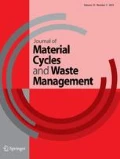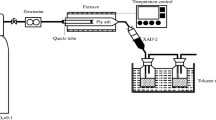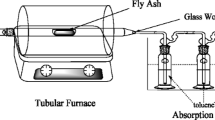Abstract
Effects of carbon concentration and Cu additive in simulated fly ash (SFA) and real fly ash (RFA) on the formation of polychlorinated dibenzofurans (PCDFs), polychlorinated dibenzo-p-dioxins (PCDDs), chlorobenzenes, and polychlorinated biphenyls which were all regarded as persistent chlorinated aromatics in iron ore sintering were investigated. In the annealing process of SFA with various carbon contents, the yield of chlorinated aromatics and the I-TEQ obtained their maximum at 10 wt% carbon content. Active carbon in SFA acted as the carbon source as well as an adsorbent which led to higher production of PCDD/F in solid phase at 10 wt% carbon content. The increase of carbon content will be beneficial on the formation of 2,3,7,8-Chloro-substituted PCDF compared with 2,3,7,8-Chloro-substituted PCDD. In addition, the CuCl2·2H2O was a much more powerful catalyst in the formation of chlorinated aromatic compounds compared with elementary Cu, since it served as both a catalyst and a chlorine donor. However, the RFA behaved similarly with SFA with elementary Cu in the formation of chlorinated aromatic compounds. The effect of carbon content and copper additives on formation of 2,3,7,8-chloro-substituted congeners displayed similar characteristics with the tetra- to octa-PCDD/F isomers and even the total PCDD/Fs.








Similar content being viewed by others
References
Fernandez-Gonzalez R, Yebra-Pimentel I, Martinez-Carballo E, Simal-Gandara J (2015) A critical review about human exposure to polychlorinated dibenzo-p-dioxins (PCDDs), polychlorinated dibenzofurans (PCDFs) and polychlorinated biphenyls (PCBs) through foods. Crit Rev Food Sci Nutr 55:1590–1617
Liu G, Liu W, Cai Z, Zheng M (2013) Concentrations, profiles, and emission factors of unintentionally produced persistent organic pollutants in fly ash from coking processes. J Hazard Mater 261:421–426
Sun Y, Liu X, Kainuma M, Wang W, Takaoka M, Takeda N (2015) Dechlorination of polychlorinated biphenyls by iron and its oxides. Chemosphere 137:78–86
Sun Y, Takaoka M, Takeda N, Wang W, Zeng X, Zhu T (2012) Decomposition of 2,2′,4,4′,5,5′-hexachlorobiphenyl with iron supported on an activated carbon from an ion-exchange resin. Chemosphere 88:895–902
Olie K, Vermeulen P, Hutzinger O (1977) Chlorodibenzo-p-dioxins and chlorodibenzofurans are trace components of fly ash and flue gas of some municipal incinerators in the Netherlands. Chemosphere 6:455–459
Karasek F (1995) An overview of dioxin formation in combustion processes. Organohalogen Compd 23:315–319
Jia H, Song C, Dai Z, Gao B (2008) Formation mechanism and control of dioxins in the process of sintering. Sintering Pellet 33:25–30 (in Chinese)
Buekens A, Stieglitz L, Hell K, Huang H, Segers P (2001) Dioxins from thermal and metallurgical processes: recent studies for the iron and steel industry. Chemosphere 42:729–735
Kasai E, Hosotani Y, Kawaguchi T, Nushiro K, Aono T (2001) Effect of additives on the dioxins emissions in the iron ore sintering process. ISIJ Int 41:93–97
Harjanto S, Kasai E, Terui T, Nakamura T (2002) Behavior of dioxin during thermal remediation in the zone combustion process. Chemosphere 47:687–693
Nakano M, Hosotani Y, Kasai E (2005) Observation of behavior of dioxins and some relating elements in iron ore sintering bed by quenching pot test. ISIJ Int 45:609–617
Grandesso E, Gullett B, Touati A, Tabor D (2011) Effect of moisture, charge size, and chlorine concentration on PCDD/F emissions from simulated open burning of forest biomass. Environ Sci Technol 45:3887–3894
Cains PW, McCausland LJ, Fernandes AR, Dyke P (1997) Polychlorinated dibenzo-p-dioxins and dibenzofurans formation in incineration: effects of fly ash and carbon source. Environ Sci Technol 31:776–785
Stanmore BR (2004) The formation of dioxins in combustion systems. Combust Flame 136:398–427
Kawaguchi T, Matsumura M (2002) Method of sinter pot test evaluation for dioxins formation on iron ore sintering. Tetsu to Hagane 88:16–22
Iino F, Imagawa T, Takeuchiet M, Sadakata M, Weber R (1999) Formation rates of polychlorinated dibenzofurans and dibenzo-p-dioxins from polycyclic aromatic hydrocarbons, activated carbon and phenol. Chemosphere 39:2749–2756
Iino F, Imagawa T, Takeuchiet M, Sadakata M (1999) De novo synthesis mechanism of polychlorinated dibenzofurans from polycyclic aromatic hydrocarbons and the characteristic isomers of polychlorinated naphthalenes. Environ Sci Technol 33:1038–1043
Ryan SP, Altwicker ER (2000) The formation of polychlorinated dibenzo-p-dioxins/dibenzofurans from carbon model mixtures containing ferrous chloride. Chemosphere 40:1009–1014
Stieglitz L, Zwick G, Beck J, Roth W, Vogg H (1989) On the de-novo synthesis of PCDD/PCDF on fly ash of municipal waste incinerators. Chemosphere 18:1219–1226
Hell K, Stieglitz L, Altwicker ER, Addink R, Will R (2001) Reactions of 2, 4, 6-trichlorophenol on model fly ash: oxidation to CO and CO2, condensation to PCDD/F and conversion into related compounds. Chemosphere 42:697–702
Xhrouet C, Pirard C, De Pauw E (2001) De novo synthesis of polychlorinated dibenzo-p-dioxins and dibenzofurans on fly ash from a sintering process. Environ Sci Technol 35:1616–1623
Takaoka M, Yamamoto T, Shiono A, Takeda N, Oshita K, Matsumoto T, Tanaka T (2005) The effect of copper speciation on the formation of chlorinated aromatics on real municipal solid waste incinerator fly ash. Chemosphere 59:1497–1505
Fujimori T, Takaoka M, Takeda N (2009) Influence of Cu, Fe, Pb, and Zn chlorides and oxides on formation of chlorinated aromatic compounds in MSWI fly ash. Environ Sci Technol 43:8053–8059
Vogg H, Metzger M, Stieglitz L (1987) Recent findings on the formation and decomposition of PCDD/PCDF in municipal solid waste incineration. Waste Manag Res 5:285–294
Matsumura M, Kawaguchi T, Kasai E (2006) Effects of promoting and suppressing materials on dioxin emissions in iron ore sintering process. Proc Asia Steel Int Conf 2006:416–421
Suzuki K, Kasai E, Aono T, Yamazaki H, Kawamoto K (2004) De novo formation characteristics of dioxins in the dry zone of an iron ore sintering bed. Chemosphere 54:97–104
Li X, Zhang J, Yan J, Chen T, Lu S, Cen K (2006) Effect of water on catalyzed de novo formation of polychlorinated dibenzo-p-dioxins and polychlorinated dibenzofurans. J Hazard Mater 137:57–61
Sun Y, Liu L, Fu X, Zhu T, Buekens A, Yang X, Wang Q (2016) Mechanism of unintentionally produced persistent organic pollutant formation in iron ore sintering. J Hazard Mater 306:41–49
Liu H, Zhang Q, Cai Z, Li A, Wang Y, Jiang G (2006) Separation of polybrominated diphenyl ethers, polychlorinated biphenyls, polychlorinated dibenzo-p-dioxins and dibenzo-furans in environmental samples using silica gel and florisil fractionation chromatography. Anal Chim Acta 557:314–320
Milligan MS, Altwicker E (1993) The relationship between de novo synthesis of polychlorinated dibenzo-p-dioxins and dibenzofurans and low-temperature carbon gasification in fly ash. Environ Sci Technol 27:1595–1601
Oberg T, Bergback B, Oberg E (2007) Different catalytic effects by copper and chromium on the formation and degradation of chlorinated aromatic compounds in fly ash. Environ Sci Technol 41:3741–3746
Takaoka M, Fujimori T, Shiono A, Yamamoto T, Takeda N, Oshita K, Uruga T, Sun YF, Tanaka T (2010) Formation of chlorinated aromatics in model fly ashes using various copper compounds. Chemosphere 80:144–149
Fujimori T, Takaoka M (2009) Direct chlorination of carbon by copper chloride in a thermal process. Environ Sci Technol 43:2241–2246
Acknowledgments
This research was financially supported by the National Natural Science Foundation of China (Project Nos. 21277010, 2141101075). We also gratefully acknowledge the funding for this research provided by the Beijing Municipal Science and Technology Committee (Project No. Z151100001515001).
Author information
Authors and Affiliations
Corresponding author
Rights and permissions
About this article
Cite this article
Zhang, Y., Liu, L., Sun, Y. et al. Formation of persistent chlorinated aromatic compounds in simulated and real fly ash from iron ore sintering. J Mater Cycles Waste Manag 19, 1437–1445 (2017). https://doi.org/10.1007/s10163-016-0537-5
Received:
Accepted:
Published:
Issue Date:
DOI: https://doi.org/10.1007/s10163-016-0537-5




